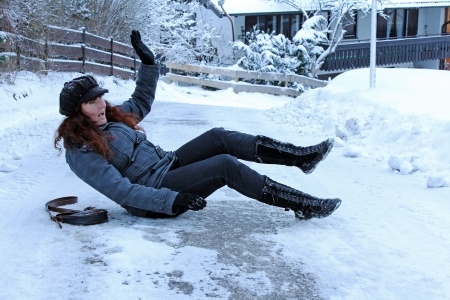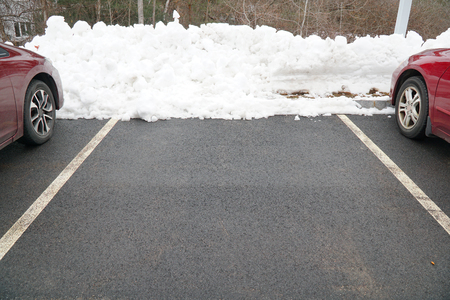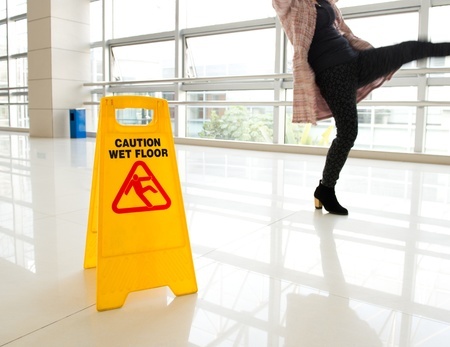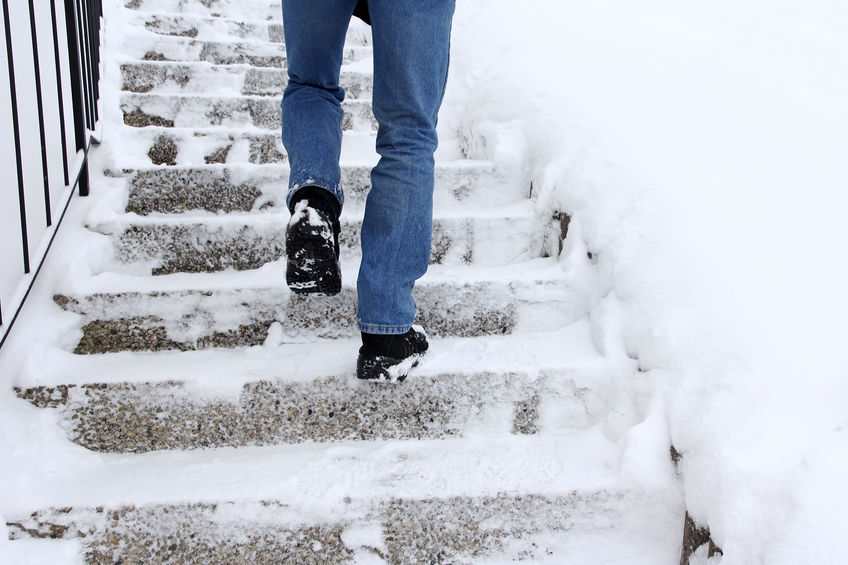

How to Prevent a Slip and Fall Accident on Icy Walkways
Winter in the Pacific Northwest means many days (and nights) with ice and snow on the ground. These slippery conditions means a dramatically increased risk for a slip and fall accident on icy walkways. Simple preventative measures on the part of walkers and property owners can help reduce the chances of a serious slip and fall injury.
Read More

Slip and Fall Accidents on Icy Walkways: Premises Liability
Slip and fall accidents on icy walkways can be particularly dangerous because they often mean falling onto unforgiving cement. In the Pacific Northwest, there is a risk of slippery ice between the end of October and the beginning on March.
Read More

Who is Liable for Inpatient Slip and Fall Accidents in Hospitals?
When an inpatient – a person receiving medical care in a hospital – has a slip and fall accident the hospital may be liable for injuries. Medical facilities and health care professionals owe a “duty of care” to their patients and part of that duty is ensuring that their patients do not suffer further injury while they are being treated or recovering from medical treatment performed in the hospital. Patient accidents in hospitals including slip and fall accidents can cause serious injuries; particularly for the elderly.
Read More

Top 10 Slip and Fall Accident Risk Factors
A slip and fall accident is a very common type of accident that is sometimes caused by unsafe conditions on someone else’s property. Property owners have a duty to use reasonable care on their property. This means being aware of dangerous conditions on their property and fixing those problems in a timely manner in order to make the property safe for visitors. Until issues are fixed, the area should be well marked to warn about the hazard. Property owners who fail to fulfill this obligation may be held liable for damages in a slip and fall accident through a premise liability claim. A personal injury attorney can help you through your slip and fall case.
Top 10 Slip and Fall Accident Risk Factors
Read More

Top 10 Slip & Fall Tips in Snowy & Icy Conditions
Winter is almost here but the temperatures are already dipping well below freezing. Snow and ice are always a possibility once the cold weather has arrived. A slip on snow or ice can mean serious injuries including fractures, dislocations and bruising to the wrists, shoulders, and ankles. There is the potential for medical care costs and/or lost wages due to time off of work. If you have slipped on ice or snow on someone else’s property you may be wondering if you can sue for damages. Slip and fall personal injury laws vary from state to state but if you have experienced a legitimate slip and fall injury do not hesitate to pursue an injury case against the property owners.
A slip and fall injury case falls under premises liability. Premises liability is an area of negligent torts that holds a public or private property owner responsible for acts or omissions in care of their property that lead to an injury. A slip and fall accident that happens on private property is typically a more complicated case.
An owner of a store, for example, owes a duty of care to his customers that he will use all reasonable care to protect his customers from injury on the store premises.
Common hazards that can lead to valid slip and fall accidents include:
- A wet floor without proper warning signage
- Products stacked high on a shelf that fall on the customer
- Broken doors or shelving
- Boxes stacked in the middle of a shopping aisle
- Icy or snowy parking lots*
*In Washington, store owners are not legally required to remove snow and ice that are naturally accumulated but if they choose to remove it, it cannot be done in a negligent manner.
Top 10 Slip & Fall Safety Tips in Snowy & Icy Conditions
A slip and fall on snow or ice can cause a serious injury, especially if you fall on concrete. Winter months can see a ten-fold increase in emergency room visits due to outdoor slip and fall accidents in icy conditions. Be aware that black ice is hard to see so a surface can look clear when it isn’t and that many slips and falls happen on front steps to your house or while walking a path to your car.
If you can, just stay home but if you are forced to go outside follow these 10 safety tips:
1. Walk with slow, deliberate, short steps with your knees slightly bent; do not jog in the ice!
2. Wear shoes with rubber soles or add shoe ice grippers around your shoes.
3. Wear bright clothing and reflective clothing if it is dark.
4. Bring a flashlight to light the path if it is dark.
5. Do not wear anything on your face that could restrict your vision.
6. Walk with your hands out of your pockets and wear gloves so you will be more likely to break your fall if you do slip.
7. Watch for overhead dangers such as hanging icicles.
8. If provided, use a handrail when descending or ascending steps.
9. Walk on a footpath or if there isn’t a footpath then walk on the right side of the road toward oncoming traffic.
10. Consider using a walking stick or ski pole.
If you or a loved one were injured in an accident, you have enough to deal with. Let an experienced accident attorney fight for the full compensation that you deserve. It is not uncommon to receive a settlement from the insurance company that is five to ten times bigger with the help of a lawyer. Call the caring accident attorneys at Tario & Associates, P.S. today for a FREE consultation! You will pay nothing up front and no attorney fees at all unless we recover damages for you!
Read More

Who is Responsible for your Slip and Fall Accident?
Slip and Injury falls are one of the biggest causes of unintentional injuries in the United States. According to National Safety Council (NSC), slip and fall accidents account for approximately 8.9 million visits to the emergency room each year and are the second-highest cause of unintentional death in homes and communities, resulting in more than 25,000 fatalities in 2009. Adults aged 55 and older are more prone to slip and fall accidents with people over the age of 65 four times as likely to die from a fall as those in any other age group.
There are things we can do to avoid slip and fall accidents and prevent them from happeing on our property.
Common Fall Hazard Locations:
- Ladders
- Stairs
- Raised areas without railings
- Ramps
- Cluttered hallways
- Doorways
- Heavy traffic areas
- Uneven surfaces
- Wet or slippery surfaces
Fall Prevention Tips for Property/Business Owners:
- Never allow someone to stand on a chair, table or other surface on wheels
- Store electrical, cable and phone cords away from traffic areas
- Remove small throw rugs or use non-skid mats to keep them from slipping
- Remove tripping hazards (paper, boxes, toys, clothes, shoes) from stairs and walkways
- Repair damaged walkways and steps in a timely manner
- Clean up spills immediately
We are all responsible to watch where we are going and should expect that there will be surface hazards from time to time. A property owner will not automatically be held responsible for your fall; if it is determined that an ordinary person would have expected the hazard to be there and avoid it then you may be deemed careless and have no case. Property owners are, however, obligated to keep their property free of obvious and unnecessary slip and fall hazards. A legal case could be decided against a property owner who is deemed neglectful of clearing hazards from his property. Each state has their own laws around slip and fall hazards.
Determining Liability for a Slip and Fall Injury
One of the following must be true for someone else to be responsible for your slip and fall injury:
- The property or business owner/family member or employee must have caused the spill, worn or torn spot, or other slippery or dangerous surface or item in the way.
- The property or business owner/family member or employee must have known of the dangerous surface but done nothing about it.
- The property or business owner/family member or employee should have known of the dangerous surface because a “reasonable” person taking care of the property would have discovered and removed or repaired it.
Although the third option is the most commonly used, it is also the most ambiguous. Liability in these cases is often decided by common sense; a judge or jury decides whether the steps the owner or occupier took to keep the property safe were reasonable. For example, could a simple barrier have been created or warning given to prevent people from slipping or tripping? Was there time to mop up a spill?
What Is “Reasonable”?
To determine a property owner’s “reasonableness,” the law asks whether the owner made regular and thorough efforts to keep the property safe and clean.
Your Carelessness
You must assess whether your carelessness contributed to the accident. The rules of “comparative negligence” help measure your own reasonableness in going where you did, in the way you did, just before the accident happened.
If you slipped and fell at someone else’s house or business the property or business owner may be held responsible for your slip and fall accident. If you think you have a legitimate legal claim for injuries incurred in a slip and fall accident, you should setup an appointment to discuss your accident with the experienced personal injury attorneys at Tario & Associates, P.S.
Read More